Annals of Emergency Medicine
Official journal of the American College of Emergency Physicians
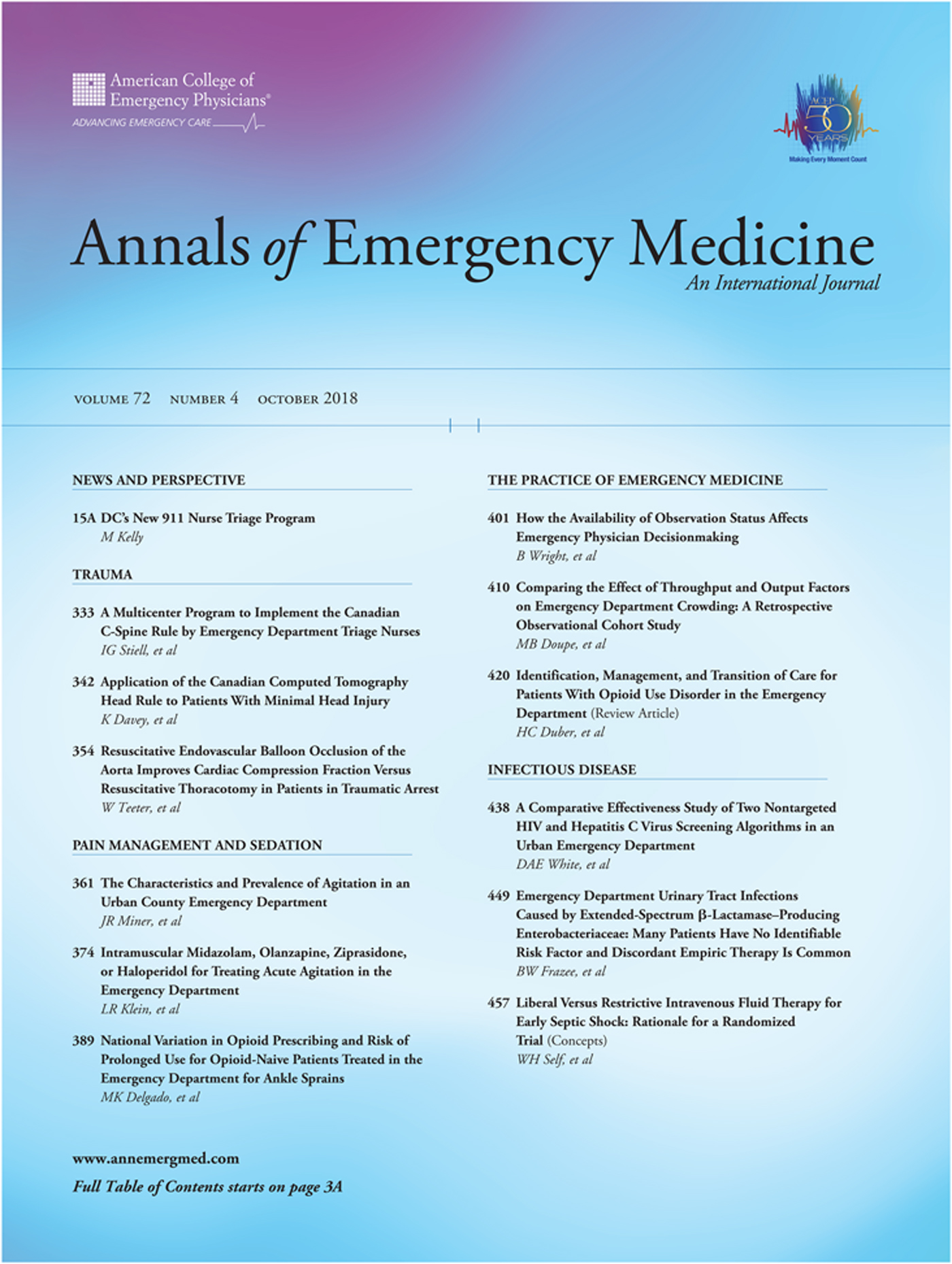
(The print version of this article has been scheduled for June 2019)
Research Pioneers in Emergency Medicine—Reflections on Their Paths to Success and Advice to Aspiring Researchers: A Qualitative Study
Wendy C. Coates, Lalena M. Yarris, Samuel O. Clarke, Daniel Runde, Jacqueline Kurth, Emilie Fowlkes, Jaime Jordan
https://doi.org/10.1016/j.annemergmed.2018.10.033
Study objective: Research in basic, translational, and clinical emergency medicine has made great strides since the formalization of emergency medicine as a specialty. Our objective is to identify and analyze strategies used by emergency medicine research pioneers to inform further advancement of research in emergency medicine, particularly for aspiring researchers and those in emerging areas, using emergency medicine medical education as one example.
Methods: This was a prospective, grounded-theory, qualitative study, using a constructivist/interpretivist paradigm. Leading basic science, translational, and clinical emergency medicine researchers who completed residency before 1995 were eligible for structured interviews. Thematic coding followed an iterative process until saturation was reached. A theoretic model was developed and analyzed.
Results: Research pioneers valued advanced methodological training and mentorship. Barriers to funding were lack of recognition of emergency medicine as a specialty, absence of a research history, and lack of training and funding resources. Deliberate interventions to improve emergency medicine research included educational sessions at national meetings, external (to emergency medicine) mentor pairings, targeted funding by emergency medicine organizations, and involvement with funding agencies. Pioneers facilitate research excellence by serving as mentors and allocating funds or protected time to develop researchers. To advance emerging subfields of research in emergency medicine, pioneers recommend advanced methodological training that is specific to the area, deliberate mentorship, and the formation of research consortia to conduct generalizable outcomes-based studies.
Conclusion: Research pioneers in emergency medicine cite mentorship, advanced skills obtained through fellowship or graduate degrees, deliberate collaboration with experienced researchers, support from emergency medicine organizations, and forming networks as the cornerstones of success.
African journal of emergency medicine
The official journal of the African Federation for Emergency Medicine, the Emergency Medicine Association of Tanzania, the Emergency Medicine Society of South Africa, the Egyptian Society of Emergency Medicine, the Libyan Emergency Medicine Association, the Ethiopian Society of Emergency Medicine Professionals, the Sudanese Emergency Medicine Society, the Society of Emergency Medicine Practitioners of Nigeria and the Rwanda Emergency Care Association
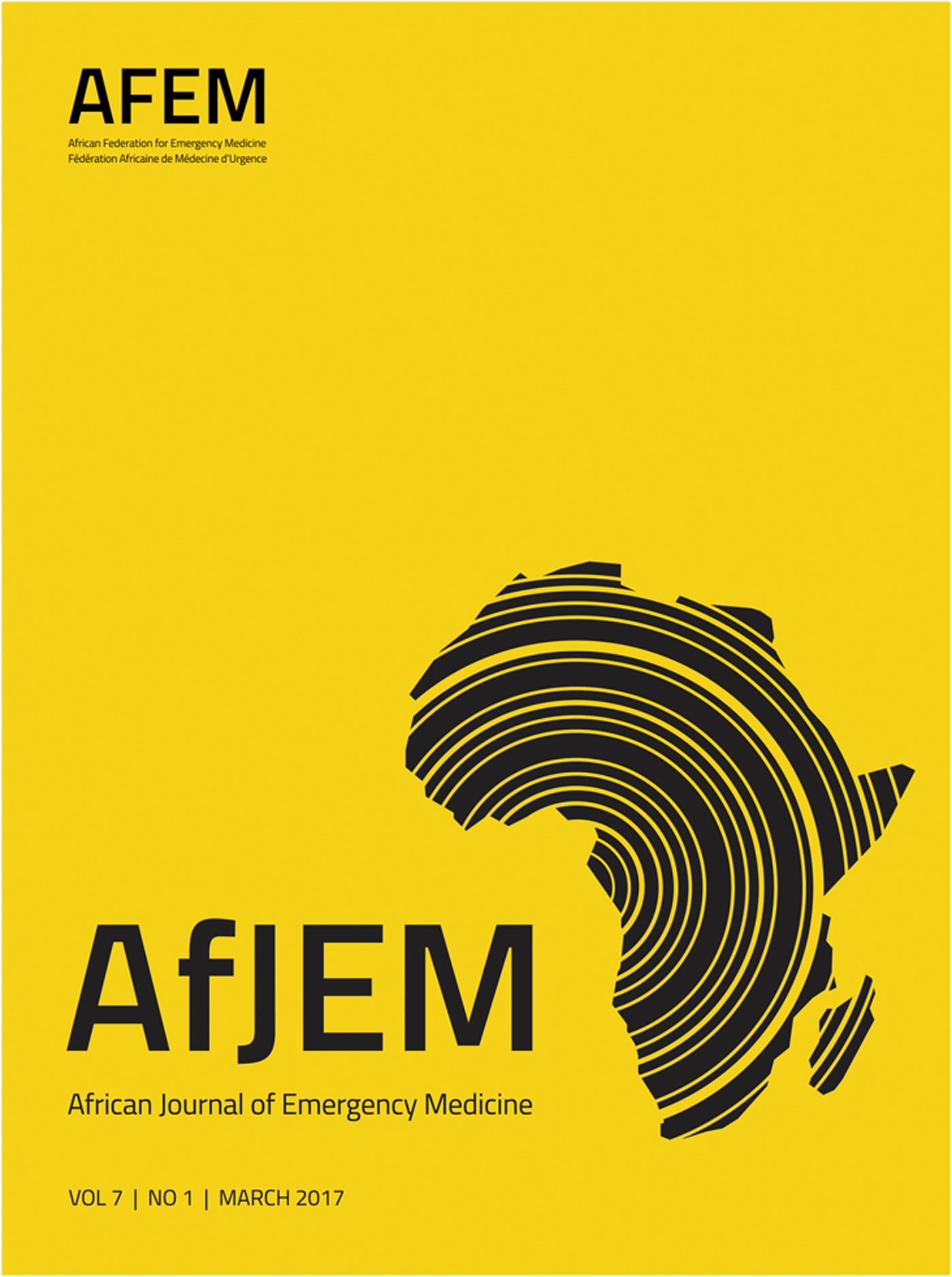
Impact of emergency medicine training implementation on mortality outcomes in Kigali, Rwanda: An interrupted time-series study
Aluisio AR, Barry MA, Martin KD, Mbanjumucyo G, Mutabazi ZA, Karim N, Moresky RT, Nyinawankusi JD, Byiringiro J, Levine AC
Afr J Emerg Med 2019;9(1):14–20
https://doi.org/10.1016/j.afjem.2018.10.002
Introduction: Although emergency medicine (EM) training programmes have begun to be introduced in low- and middle-income countries (LMICs), minimal data exist on their effects on patient-centered outcomes in such settings. This study evaluated the impact of EM training and associated systems implementation on mortality among patients treated at the University Teaching Hospital-Kigali (UTH-K).
Methods: At UTH-K an EM post-graduate diploma programme was initiated in October 2013, followed by a residency-training programme in August 2015. Prior to October 2013, care was provided exclusively by general practice physicians (GPs); subsequently, care has been provided through mutually exclusive shifts allocated between GPs and EM trainees. Patients seeking Emergency Centre (EC) care during November 2012–October 2013 (pre-training) and August 2015–July 2016 (post-training) were eligible for inclusion. Data were abstracted from a random sample of records using a structured protocol. The primary outcomes were EC and overall hospital mortality. Mortality prevalence and risk differences (RD) were compared pre- and post-training. Magnitudes of effects were quantified using regression models to yield adjusted odds ratios (aOR) with 95% confidence intervals (CI).
Results: From 43,213 encounters, 3609 cases were assessed. The median age was 32years with a male predominance (60.7%). Pre-training EC mortality was 6.3% (95% CI 5.3–7.5%), while post-training EC mortality was 1.2% (95% CI 0.7–1.8%), constituting a significant decrease in adjusted analysis (aOR=0.07, 95% CI 0.03–0.17; p<0.001). Pre-training overall hospital mortality was 12.2% (95% CI 10.9–13.8%). Post-training overall hospital mortality was 8.2% (95% CI 6.9–9.6%), resulting in a 43% reduction in mortality likelihood (aOR=0.57, 95% CI 0.36–0.94; p=0.016).
Discussion: In the studied population, EM training and systems implementation was associated with significant mortality reductions demonstrating the potential patient-centered benefits of EM development in resource-limited settings.
Reproduced with permission
Emergency Medicine Journal
Official Journal of the Royal College of Emergency Medicine
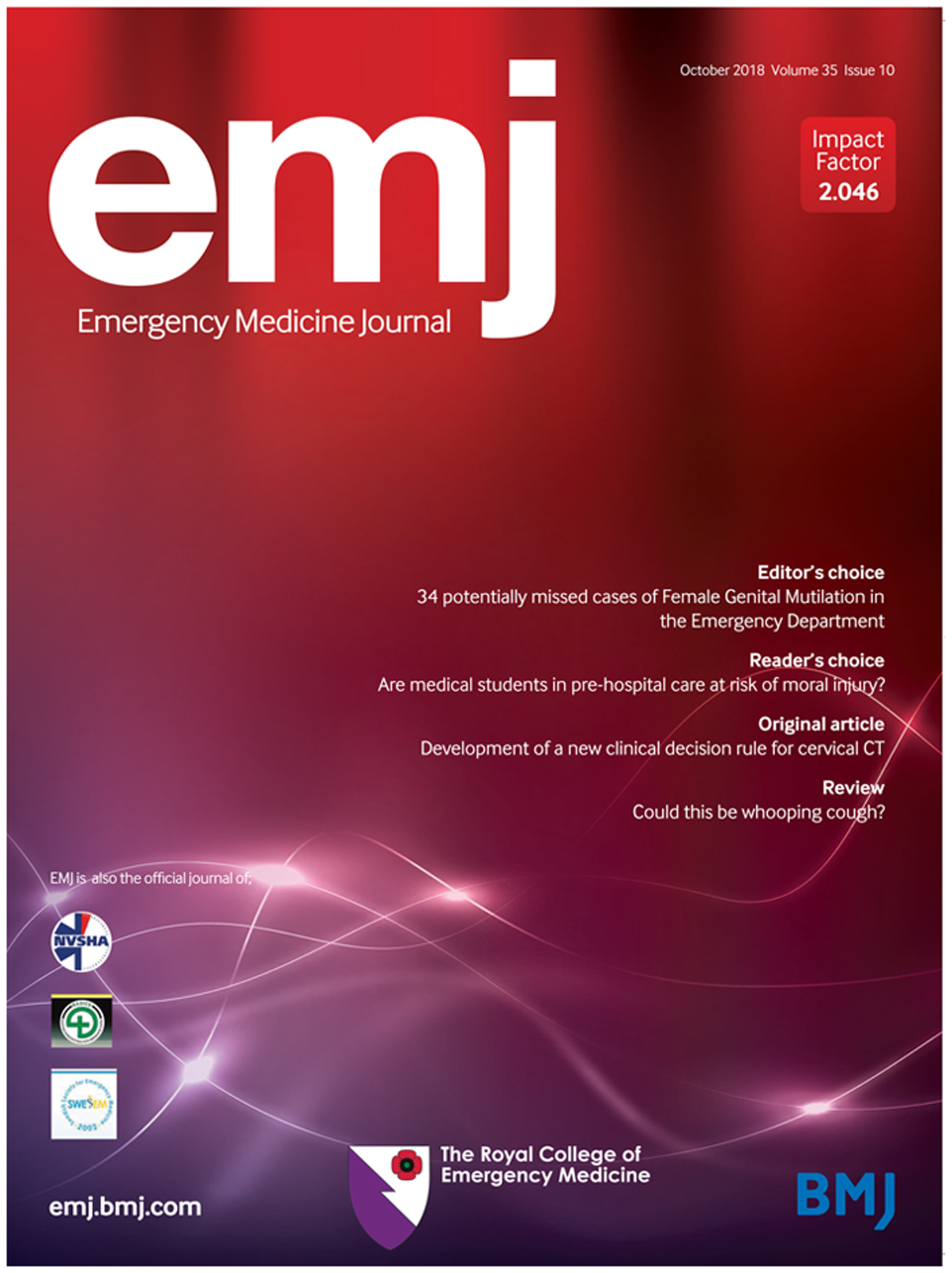
Prehospital determinants of successful resuscitation after traumatic and non-traumatic out-of-hospital cardiac arrest
Barnard Barnard, Daniel D Sandbach, Tracy L Nicholls, Alastair W Wilson, Ari Ercole
http://dx.doi.org/10.1136/emermed-2018-208165
Introduction: Out-of-hospital cardiac arrest (OHCA) is prevalent in the UK. Reported survival is lower than in countries with comparable healthcare systems; a better understanding of outcome determinants may identify areas for improvement.
Methods: An analysis of 9109 OHCA attended in East of England between 1 January 2015 and 31 July 2017. Univariate descriptives and multivariable analysis were used to understand the determinants of survival for nontraumatic cardiac arrest (NTCA) and traumatic cardiac arrest (TCA). Two Utstein outcome variables were used: survival to hospital admission and hospital discharge.
Results: The incidence of OHCA was 55.1 per 100 000 population/year. The overall survival to hospital admission was 27.6% (95% CI 26.7% to 28.6%) and the overall survival to discharge was 7.9% (95% CI 7.3% to 8.5%). Survival to hospital admission and survival to hospital discharge were both greater in the NTCA group compared with the TCA group: 27.9% vs 19.3% p = 0.001, and 8.0% vs 3.8% p = 0.012 respectively. Determinants of NTCA and TCA survival were different, and varied according to the outcome examined. In NTCA, bystander cardiopulmonary resuscitation (CPR) was associated with survival at discharge but not at admission, and the likelihood of bystander CPR was dependent on geographical socioeconomic status. An air ambulance was associated with increased survival to both hospital admission and discharge in NTCA, but only with survival to admission in TCA.
Discussion: NTCA and TCA are clinically distinct entities with different predictors for outcome—future OHCA reports should aim to separate arrest aetiologies. Determinants of survival to hospital admission and discharge differ in a way that likely reflects the determinants of neurological injury. Bystander CPR public engagement may be best focused in more deprived areas.
Emergencias
emergencias.portalsemes.org/English
Official Journal of the Spanish Society of Emergency Medicine
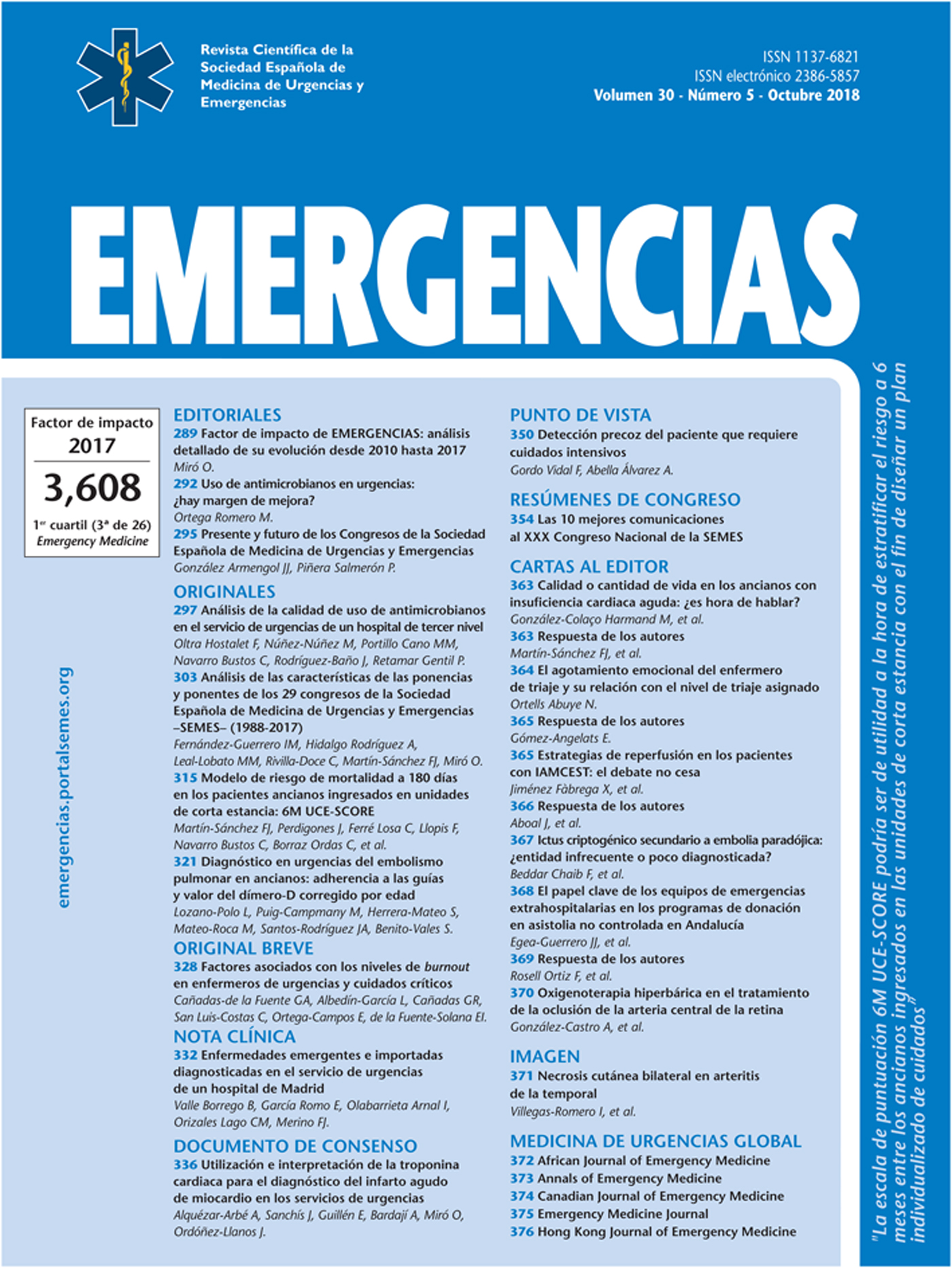
Factors associated with the activation of emergency medical services in patients with acute stroke: a prospective study
Raúl Soto-Cámara, José M. Trejo-Gabriel-Galán, Jerónimo González-Bernal,Josefa González-Santos, Esther Cubo
Cited: Soto-Cámara R, Trejo-Gabriel-Galán JM, González-Bernal J, González-Santos J, Cubo E. Factors associated with the activation of emergency medical services in patients with acute stroke: a prospective study. Emergencias. 2019;31:86–90.
Objective: To identify factors associated with activation of emergency medical services (EMS) in stroke.
Methods: Cross-sectional study of all patients admitted with stroke to Hospital Universitario de Burgos in Spain between September 1, 2015, and August 31, 2016. We recorded sociodemographic, clinical, behavioral, cognitive, and context information and explored possible associations with calls for EMS units.
Results: Three hundred eleven patients were included. EMS units were activated in 171 cases (55%) associated with an assessment that the patient was unable to manage the health situation from the onset of symptoms (adjusted odds ratio [OR], 6.95; 95% CI, 3.64–13.26), a witness's call for help (rather than the patient's) (OR, 5.68; 95% CI, 2.99–10.83), serious neurological deficit defined by a score over 16 on the National Institute of Health Stroke Scale (OR, 4.51; 95% CI, 1.10–18.46), a patient's awareness of serious symptoms leading to a call for help (OR, 4.03; 95% CI, 1.42–11.42), and a patient's history of high blood pressure (OR, 2.38; 95% CI, 1.25–4.54).
Conclusion: Calls for EMS attendance from either a patient or a witness are associated with objective signs of severe stroke and subjective perception of severity.
Keywords: Emergency medical services. Stroke. Ambulance services. Patient transport. Time factors.
Hong Kong Journal of Emergency Medicine
Official Journal of the Hong Kong College of Emergency Medicine
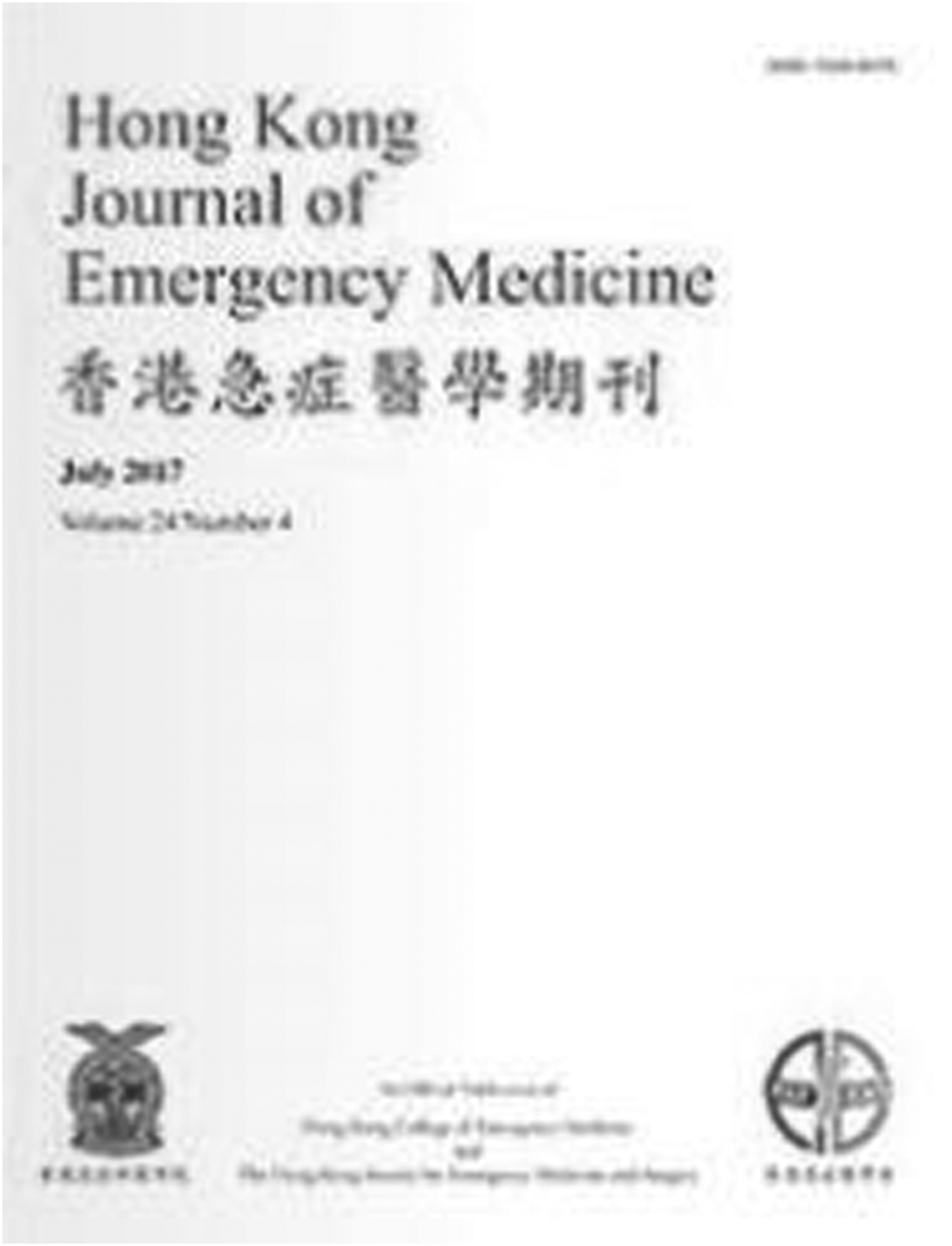
Readiness of Hong Kong secondary school teachers for teaching cardiopulmonary resuscitation in schools: A questionnaire survey
Min Fan, Ling-Pong Leung, Reynold Leung, Suet Hon and Kit Ling Fan
Background: S Bystander cardiopulmonary resuscitation can improve the survival rate of patients with out-of-hospital cardiac arrest. Teaching cardiopulmonary resuscitation in schools by teachers is one of the ways to increase the number of bystanders who can perform cardiopulmonary resuscitation. Nevertheless, there have been no studies on the readiness of teachers in Hong Kong to teach cardiopulmonary resuscitation in their schools.
Objective: To assess whether secondary school teachers are prepared to teach their students cardiopulmonary resuscitation.
Methods: This was a questionnaire survey. Teachers from 22 local secondary schools were recruited. The questionnaires were designed with questions covering their knowledge about cardiopulmonary resuscitation and attitudes towards teaching their students cardiopulmonary resuscitation. A knowledge score and attitude score were calculated.
Results: 557 teachers completed the questionnaires. Most had never witnessed a cardiac arrest and over half of them had never been trained cardiopulmonary resuscitation or use of an automated defibrillator. About 25% of them answered all questions on knowledge wrong. Only 25% supported teaching cardiopulmonayr resuscitation in schools and 32% were willing to teach it. Legal liability was a major concern.
Conclusion: Local teachers’ readiness for teaching students cardiopulmonary resuscitation in secondary schools is likely poor. More efforts are required to raise their knowledge level on cardiopulmonary resuscitation and instill a positive attitude towards cardiopulmonary resuscitation education in schools.
Keywords: Cardiopulmonary resuscitation teaching in school, Hong Kong, questionnaire


